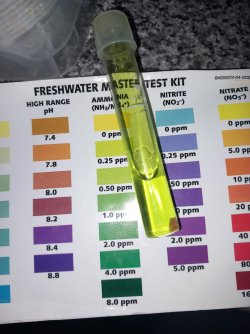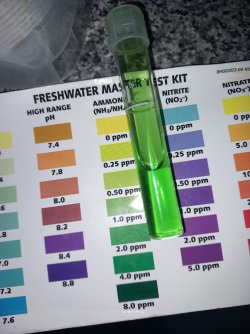Hi all
I usually add a cap of liquid fertiliser in my tank with each water change. I have added root tabs every so often when I first set the tank up but hadn't done so for several months.
Earlier this week I added a few during a water change as I put some new bulbs in. I tested the water the next day and there was an ammonia spike in both my tanks (less so in the 6gal as I only added one but still above 0).
The tabs I've been putting in are unbranded but look like this - https /www.ebay.co.uk/itm/334391427841?itmmeta=01J4VHAXCDQCNQAGYP0KH5D7RB&hash=item4ddb484301:g:80EAAOSwpZ5iSwLu&itmprp=enc:AQAJAAAA4GnEQT2sQC+8Z6MZjcXgZqQEeWZJRhHMGXbyGvrNOtNRrrCvVdIhtpL7vtQFFJm5Bsq3kX2l/7Tth8T3BoltwziMGEHyQlEs5mQS+DO7xT4Tj7wpHc/0bSZlyB++lhr+LD/UBU0rQ9lG7OCsc6Q6jq67ACkjnnRgG/YDmc3bOXIl+6F0XlB605wZc8eiUWwkGDfhoTdqbUve4OgTUIVtwtLkhkfjr8T8sc/9MRWBh0RGvWMdZ/ftl8cqI9WhEQ3Ei67qCdnlA6u4STbwtFSKp30GHk7H9Nx3PA5QgF/EJ8lW|tkp:BFBMotar8aZk. I've used them before with no issues.
/www.ebay.co.uk/itm/334391427841?itmmeta=01J4VHAXCDQCNQAGYP0KH5D7RB&hash=item4ddb484301:g:80EAAOSwpZ5iSwLu&itmprp=enc:AQAJAAAA4GnEQT2sQC+8Z6MZjcXgZqQEeWZJRhHMGXbyGvrNOtNRrrCvVdIhtpL7vtQFFJm5Bsq3kX2l/7Tth8T3BoltwziMGEHyQlEs5mQS+DO7xT4Tj7wpHc/0bSZlyB++lhr+LD/UBU0rQ9lG7OCsc6Q6jq67ACkjnnRgG/YDmc3bOXIl+6F0XlB605wZc8eiUWwkGDfhoTdqbUve4OgTUIVtwtLkhkfjr8T8sc/9MRWBh0RGvWMdZ/ftl8cqI9WhEQ3Ei67qCdnlA6u4STbwtFSKp30GHk7H9Nx3PA5QgF/EJ8lW|tkp:BFBMotar8aZk. I've used them before with no issues.
I did a 50% water change straight away and tried to remove as much of the tabs as possible. Left it 24 hours, tested again but still have ammonia, so have done another 50% water change. Have tested again this morning and still have ammonia. Have included pics below.
Is there anything else I can do to try and help? I'm using remineralised RO water so I know there's no ammonia in my source water. Short of digging up my substrate to get out any remaining bits of root tab I'm a bit stuck! I've got some seachem prime I could put in but know that's only a temp fix.
**first pic with lower ammonia reading is my 6gal where I just put 1 tab in, 2nd pic with higher reading is my 30gal where I put 3 or 4 tabs in.
I usually add a cap of liquid fertiliser in my tank with each water change. I have added root tabs every so often when I first set the tank up but hadn't done so for several months.
Earlier this week I added a few during a water change as I put some new bulbs in. I tested the water the next day and there was an ammonia spike in both my tanks (less so in the 6gal as I only added one but still above 0).
The tabs I've been putting in are unbranded but look like this - https
 /www.ebay.co.uk/itm/334391427841?itmmeta=01J4VHAXCDQCNQAGYP0KH5D7RB&hash=item4ddb484301:g:80EAAOSwpZ5iSwLu&itmprp=enc:AQAJAAAA4GnEQT2sQC+8Z6MZjcXgZqQEeWZJRhHMGXbyGvrNOtNRrrCvVdIhtpL7vtQFFJm5Bsq3kX2l/7Tth8T3BoltwziMGEHyQlEs5mQS+DO7xT4Tj7wpHc/0bSZlyB++lhr+LD/UBU0rQ9lG7OCsc6Q6jq67ACkjnnRgG/YDmc3bOXIl+6F0XlB605wZc8eiUWwkGDfhoTdqbUve4OgTUIVtwtLkhkfjr8T8sc/9MRWBh0RGvWMdZ/ftl8cqI9WhEQ3Ei67qCdnlA6u4STbwtFSKp30GHk7H9Nx3PA5QgF/EJ8lW|tkp:BFBMotar8aZk. I've used them before with no issues.
/www.ebay.co.uk/itm/334391427841?itmmeta=01J4VHAXCDQCNQAGYP0KH5D7RB&hash=item4ddb484301:g:80EAAOSwpZ5iSwLu&itmprp=enc:AQAJAAAA4GnEQT2sQC+8Z6MZjcXgZqQEeWZJRhHMGXbyGvrNOtNRrrCvVdIhtpL7vtQFFJm5Bsq3kX2l/7Tth8T3BoltwziMGEHyQlEs5mQS+DO7xT4Tj7wpHc/0bSZlyB++lhr+LD/UBU0rQ9lG7OCsc6Q6jq67ACkjnnRgG/YDmc3bOXIl+6F0XlB605wZc8eiUWwkGDfhoTdqbUve4OgTUIVtwtLkhkfjr8T8sc/9MRWBh0RGvWMdZ/ftl8cqI9WhEQ3Ei67qCdnlA6u4STbwtFSKp30GHk7H9Nx3PA5QgF/EJ8lW|tkp:BFBMotar8aZk. I've used them before with no issues.I did a 50% water change straight away and tried to remove as much of the tabs as possible. Left it 24 hours, tested again but still have ammonia, so have done another 50% water change. Have tested again this morning and still have ammonia. Have included pics below.
Is there anything else I can do to try and help? I'm using remineralised RO water so I know there's no ammonia in my source water. Short of digging up my substrate to get out any remaining bits of root tab I'm a bit stuck! I've got some seachem prime I could put in but know that's only a temp fix.
**first pic with lower ammonia reading is my 6gal where I just put 1 tab in, 2nd pic with higher reading is my 30gal where I put 3 or 4 tabs in.
Attachments
As an eBay Associate we earn from qualifying purchases.



